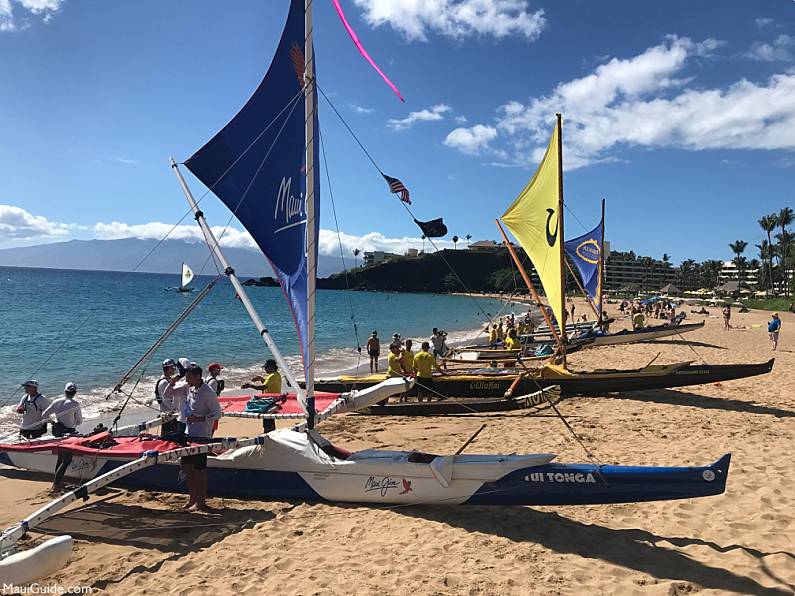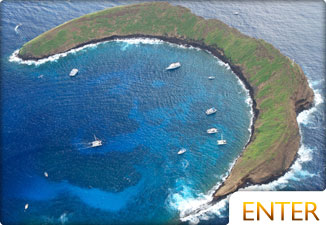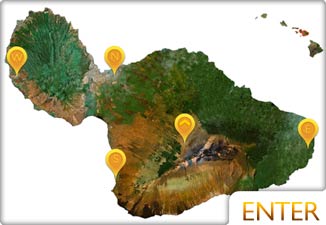Maui > Events > Canoe Festival
Annual Waʻa Hawaiian Canoe Festival
Under the Huaka of a Wa’a
by Erik Blair
-
waʻa – noun – Canoe, rough-hewn canoe, paddlers; a chant in praise of a chief’s canoe.
About The Hawaiian Canoe Festival
In the Hawaiian language, Wa’a Kaikahi means a canoe with a single mast. Earlier in the week, I witnessed the wind-filled sails of a few of these Hawaiian sailing canoes dancing their way past Kihei towards the West Side. The Hawaiian Canoe Festival will begin soon.
On the morning of the Waʻa Kiakahi event, I was early to the beach where numerous canoes were staged for the days sailing activities. Teams from all over Hawaii brought their canoes to this beach to share their skill, passion, and a little history too. I watched as rigging and sail were prepared with many smiles and much laughter.
This was the Kaanapali Beach Resort Association‘s 8th year of celebrating the Waʻa Kiakahi Canoe Festival which is put on by the Hawaiian Sailing Canoe Association every year. The partnership between the KBRA and HSCA is rich with new and old friends that share the mission to “to learn, revive, educate and practice” ancient Hawaiian “skills and values as they relate to sailing canoes and the Hawaiian culture” during the festival.
While the festival is a fantastic way to learn about Polynesian seafaring culture, it only comes around once a year. For a thorough introduction to Hawaiian canoe sailing, set your sights on Maui Sailing Canoe. This family-owned business offers year-round snorkeling tours aboard their wa’a kiakahi— a single mast canoe. Sail and paddle along Wailea’s pristine coast just as the early Hawaiians did, and snorkel one of the area’s many pristine reefs alongside tropical fish and sea turtles. Unlike other snorkeling excursions, this experience emphasizes Hawaiian culture, history, and traditions. Headed by lifelong paddlers, surfers, sailors, and Cal Maritime graduates, Maui Sailing Canoe affords visitors an authentic glimpse into ancient Hawaiian navigation and sailing tradition.
25 Best Things To Do on Maui
I’d never been on a Hawaiian canoe, let alone a sailing vessel, and suddenly it was my turn to embark on my Wa’a adventure. The captain suggested I position myself towards the middle trying not to mention that more ballast is needed there. I made my way under the mast and noted that because I was tall that I’d need to duck at nearly every turn of the canoe. Most Hawaiian-style canoes have a float or secondary hull, fixed parallel to the canoe to stabilize it, called an outrigger. Some of the 8 passengers leaped up onto the starboard and port “pola” which is a central platform or deck of a waʻa that is fastened to the ʻiako between the ama and the main hull. In front of me were two paddlers and behind me one more with the captain at the aft. Once off the beach, the wind filled the sail, and with great speed, we were pushed far out beyond the shallow water and into the blue.
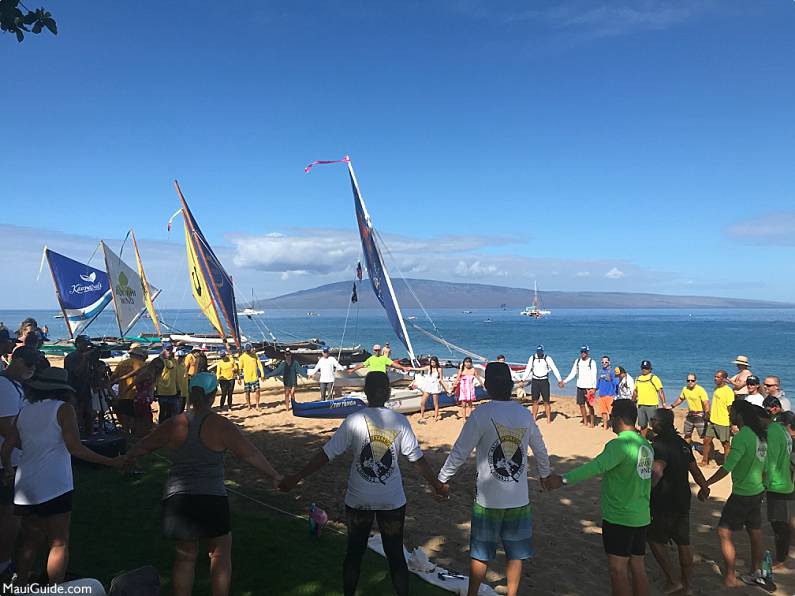
My one sail upon the Waʻa would end with a sadness that this event only happened once a year. I’d accomplished one significant task on my bucket list and made a few friends along the way, but later something brought even more meaning to me. I watched as a child playing under the pola of a Waʻa, noting that the shadow or “huaka” cast upon that sand on this day was indistinguishable from those once shared at this very place in a distant Hawaiian past.
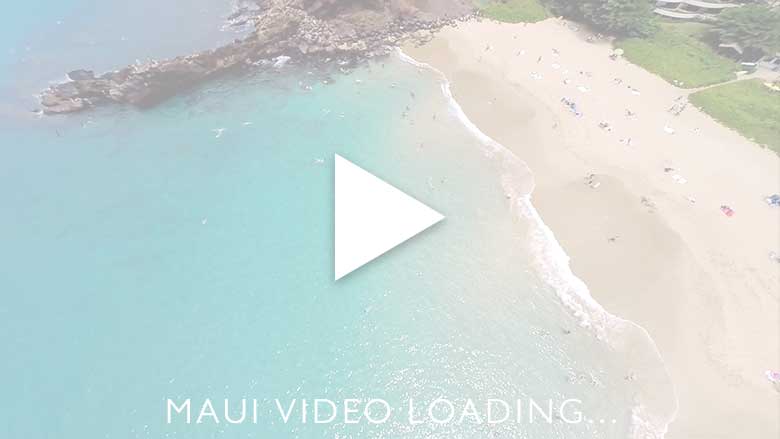
The various parts of a Waʻa Sailing Canoe:
ʻaha: braided or twisted cord used in lashing the canoe, made of pulu-niu (coconut husk fiber), olona fiber, or hau (hibiscus bark fiber); ‘aha-niu: cordage made of pulu-niu
ʻakea: hull of an outrigger canoe; starboard hull of a double canoe
ama: float on an outrigger canoe; port hull of a double canoe.
awa: harbor, port, cove; awa ku waʻa: canoe harbor or anchorage; awa pae: landing place
ʻeku: “snout” of the canoe, the prow, which digs into the ocean as the snout of a pig digs into the earth
halau waʻa: canoe house
heleuma: anchor
hoe: a paddle; to paddle
hoe uli: center steering paddle; hoe ama: port steering blade; hoe ʻakea: starboard steering blade
ʻiako: arched crossbeams which fasten the floater (ama) to the hull in an outrigger canoe
iwikuamoʻo: keel
iwi kaʻele: keel
kaʻele: canoe hull
kaula: line; kaule hau: hau (hibiscus) rope
kaula hope: backstay, or line from mast to stern
kaula huki: halyard, or line used to haul up the sail
kaula ihu: forestay; line from mast to bow.
kaula lana: mooring line

kaula luahine: lashing line running alongside the canoe (in the moʻo on Hokuleʻa) to which the paʻu or ahu (storm cover) is lashed
kaula paʻa: stay; a line to secure the mast
kaula paepae: sheets (lines controlling the angle of the sail to the wind)
kaula peʻa: tricing line; used to open and close sail
kaula pu: shrouds (lines which stay the masts to each side of the vessel)
kaupoʻi: median canoe-bow cover
kawelewele: ropes used to assist in righting a capsized canoe
keʻa: beams connecting the hulls of a double canoe
kia: mast; kia hope: aftermast; Hokuleʻa’s was named “Heiau” by Chief Tofa in 1976; kia
ihu: foremast Hokule’a’s was named “Terikitu” by Chief Tofa in 1976.
kiʻi: tiki, or carved image of a god; kiʻi kane: the male tiki; kiʻi wahine: the female tiki
ko waʻa: line for towing a canoe, or dragging a canoe hull down from the mountain forest where it was chopped down and rough-hewn.
NEW: Kapalua Guide
kua ʻiako: portion of the ʻiako lashed to the canoe hull
kuamoʻo: hull; keel
kuapoʻi: weatherboard
kumu kia: mast step; kumuhonua: base of the mast step
kupe: curved endpieces covering the fore and aft parts of the hull; also called “manu”; kupe also means “to steer a canoe”
la: sail; la-hope: aftersail; la-ihu: foresail
lanalana: ornamental lashing which binds the ama to the ʻiako in an outrigger canoe
lei hulu: feather lei flown from the tip of the boom
liu: bilge, or inside bottom of the hull
lona: blocks on which a canoe rest when out of water
maka ihu: the point at the bow end of a canoe
manu: curved endpieces covering the fore and aft parts of the hull; manu hope: back manu;
manu ihu: forward manu
moamoa: the point at the stern end of a canoe
moʻo: side planks fastened to the top edges of the hulls to increase the height of the sides of the canoe above the waterline
mouo: buoy
muku: the part of the ʻiako or keʻa (crossbeams) which extends beyond the hull
niao: the rim of the hull
noho: seat

ʻo peʻa: spar, or sprit; on Hokuleʻa, the spar is fastened to the luff (leading edge) of the sail, and is drawn up to the mast by the halyards
ʻopeʻope: bundles, packages, baggage brought on board the canoe
paepae: boom; the spar to which the foot of the sail is fastened, and to which are fastened the sheets (lines for controlling the angle of the sail to the wind); the boom is raised and lowered with tricing lines
pale: barrier; pale-kai or pale-wai: splash guards, sideboards, or weatherboards, used to keep breaking waves or swells out of the hull; pale kana: safety railing along or around the deck
paʻu: storm covers that fit over the openings of the hulls
peʻa: sail; peʻa hope: aft-sail; peʻa ihu: foresail
pepeiao: “ear” or projections on the inside of the hull to hold the seats
pola: center platform or deck of a waʻa kaulua (double-hulled canoe); also called papahele
polena: forestay; “polena” also means “furled, as a sail is furled” (see kaula ihu).
pueo: shrouds
puku: a triple-hulled canoe
wae: spreader, used to keep the hulls of a canoe from collapsing inward
“Parts of the Hawaiian Canoe” have been borrowed from the Hawaiian Voyaging Traditions page from Hawaii.edu.


